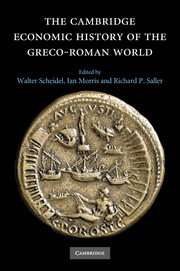Book contents
- Frontmatter
- 1 Introduction
- Part I Determinants of Economic Performance
- Part II Early Mediterranean Economies and the Near East
- Part III Classical Greece
- Part IV The Hellenistic States
- 15 The Hellenistic Near East
- 16 Hellenistic Egypt
- 17 Hellenistic Greece and Western Asia Minor
- Part V Early Italy and the Roman Republic
- Part VI The Early Roman Empire
- Part VII Regional Development in the Roman Empire
- Part VIII Epilogue
- Bibliography
- Index
- Map 1.1 The Mediterranean basin"
- Map 10.1 Greek and Phoenician trade in the period of the Persian Wars"
- Map 11.1 The Achaemenid empire"
- Map 12.1 Greece and Asia Minor"
- Map 15.1 The Seleucid empire"
- Map 16.1 Greco-Roman Egypt"
- Map 20.1 The Roman empire at the accession of Vespasian"
- References
17 - Hellenistic Greece and Western Asia Minor
from Part IV - The Hellenistic States
Published online by Cambridge University Press: 28 March 2008
- Frontmatter
- 1 Introduction
- Part I Determinants of Economic Performance
- Part II Early Mediterranean Economies and the Near East
- Part III Classical Greece
- Part IV The Hellenistic States
- 15 The Hellenistic Near East
- 16 Hellenistic Egypt
- 17 Hellenistic Greece and Western Asia Minor
- Part V Early Italy and the Roman Republic
- Part VI The Early Roman Empire
- Part VII Regional Development in the Roman Empire
- Part VIII Epilogue
- Bibliography
- Index
- Map 1.1 The Mediterranean basin"
- Map 10.1 Greek and Phoenician trade in the period of the Persian Wars"
- Map 11.1 The Achaemenid empire"
- Map 12.1 Greece and Asia Minor"
- Map 15.1 The Seleucid empire"
- Map 16.1 Greco-Roman Egypt"
- Map 20.1 The Roman empire at the accession of Vespasian"
- References
Summary
introduction
The conventional boundaries of the “Hellenistic period” – the death of Alexander the Great in 323 bc and the Battle of Actium in 31 bc – were unquestionably important political events, but their relevance for understanding economic history is less clear. In many ways the third century shows more economic links to the preceding hundred years than to the following two hundred. After 200 the increasing presence of Italian troops, traders, and settlers in the Aegean world and western Asia Minor transformed much of the political, social, cultural, and economic life of “old Greece.” Several markers point to new economic configurations after 200 bc – activity that may represent new, trans-Mediterranean links between west and east (perhaps groundwork for the more integrated Mediterranean of the first three centuries ad) and perhaps some real, though slight, productivity growth.
Politically, the Hellenistic world saw first the creation of great new Greco-Macedonian empires on the ashes of the Persian empire and second the intrusion of Rome. Van der Spek and Manning (Chapters 15–16) review the impact of these phenomena on southerly and eastern parts of the Middle East. In this chapter I focus on “old Greece” – the southern Balkans, the Aegean islands, and western Asia Minor. Greek-speakers had settled this region centuries earlier. The polis remained the basic political unit, although earlier formations persisted, especially in Asia Minor and northwestern Greece, and new, or re-configured old, political arrangements like the federations of the Aetolians or Achaeans complicated the scene. Non-Greeks like the Carians and Lycians remained in much of Asia Minor, but their identities, which had taken on Greek features across earlier centuries, weakened further in Hellenistic times.
Keywords
- Type
- Chapter
- Information
- The Cambridge Economic History of the Greco-Roman World , pp. 460 - 484Publisher: Cambridge University PressPrint publication year: 2007
References
- 7
- Cited by



